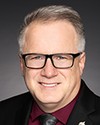Mr. Speaker, it is an honour to appear before the House today to talk about the main estimates, but I want to take a moment to thank my friend, who went before me. I share the respect she showed for our military and those who serve to protect the freedoms we enjoy. I thank her very much for that and her heartfelt speech.
Voted expenditures cover an extraordinarily wide range of programs and activities, including the Canadian Forces, health services for first nations, veterans' benefits and support for housing. In my speech today, I will be focusing on the Canadian dental care plan and the wonderful impact it has already had on the oral health of eligible Canadian residents across the country and of course in my hometown of Richmond, British Columbia.
With respect to the importance of health care, we all know that Canadians need accessible and affordable health care services. It is important that we recognize that dental care is health care. We know that regular visits to oral health professionals can help reduce the risk of a number of serious health issues, including cardiovascular disease and stroke. Helping catch health issues early on is important to our own well-being and is also important on a much larger scale since it helps reduce the burden on our health care system. Unfortunately, too many Canadians have been going without regular oral health care. Studies have found that a third of Canadians do not have dental insurance and one in four has not been able to see an oral health provider because of the cost.
Canadians should not have to choose between paying their bills and getting the care they need. That is why, in December 2023, the Government of Canada launched one of the largest social programs in Canadian history, the Canadian dental care plan, also known as the CDCP.
The CDCP is a national plan being delivered in all provinces and territories. It is making the cost of oral health care more affordable for up to nine million Canadians who do not have access to dental insurance and who have an adjusted family net income of less than $90,000 per year. The plan is making a wide range of oral health care services more affordable. The services include preventative care, such as scaling, as well as other services, such as exams, X-rays, fillings, dentures and root canal treatments. The CDCP also considers coverage for additional services and treatments, such as crowns, the initial placement of partial dentures and general anaesthesia through pre-authorization.
As members can imagine, launching one of the largest social programs in Canadian history was no easy task. To ensure a smooth onboarding process for eligible Canadians and providers alike, the CDCP was rolled out using a phased approach. The Government of Canada started its onboarding first with seniors in 2023, then adults with a valid disability tax credit certificate and children under 18 in 2024. Last month, the CDCP applications opened to all remaining eligible Canadians, fulfilling the government's commitment to fully implementing the plan in 2025.
Throughout the launch, letters were sent to Canadian residents in the eligible income range inviting them to apply to the CDCP, increasing the plan's awareness at each stage of implementation. So far, more than four million Canadians have been approved to be part of the plan, and more than two million have already gone to get care.
This is a remarkable achievement in a very short amount of time and one that would not have been possible without the support of oral health providers and their associations across the country. Oral health providers from coast to coast to coast acknowledge the need to provide better access to oral health services, and their dedication and commitment to providing care to their patients are very commendable.
The Government of Canada, with the help and collaboration of many stakeholders across the country, implemented a plan informed by provider associations, oral health experts and research findings. This work continues to solidify the importance of working together with partners within the oral health community to inform the implementation of the CDCP now and in the future as the plan continues to evolve.
To date, more than 25,000 oral health providers are participating in the plan. That is more than 22,000 dentists and dental specialists, more than 2,000 denturists and more than 1,000 independently practising hygienists caring for patients covered under the CDCP. Additionally, 19 educational institution clinics that train future Canadian oral health providers are participating in the CDCP. Their participation means greater access to oral health care for patients and more learning opportunities for students in training settings.
By participating in the plan and accepting to take on CDCP clients, these providers are helping millions of Canadians get access to the care they need. The success of the plan would not have been possible without the high level of participation of these oral health professionals. On behalf of the Government of Canada, I wish to thank all the oral health professionals who contributed to this success and continue to do so.
I am going to share some stories. The stories heard since the launch of the CDCP have been heartbreaking and uplifting at the same time.
A patient had half of their complete denture broken off for over a decade, unable to afford a replacement. Another Canadian shared that the CDCP has been life-changing for them, as having an autoimmune illness impacted their teeth and their confidence. Being able to finally get their smile fixed has been life-changing. An 89-year-old woman in a wheelchair got her teeth cleaned by a mobile dental hygienist. She was finally able to receive the care she needed at her long-term care facility. These are only a few of the many patients who had difficulty eating properly or who lived with pain for decades because they could not afford the care, patients who, thanks to the CDCP, are finally getting the care they very much needed.
A denturist told us that some of his CDCP patients had gone 15 years without dentures because they could not afford them. An independent dental hygienist shared that some of her CDCP clients had not received dental care in the last 30 years. A dentist was surprised to find three cases of undiagnosed oral health cancer in his first week of treating CDCP patients. That is three patients with a better chance of survival because of the CDCP. These are just a few testimonials of the many heard over the past year and a half from providers and their patients. It is fair to say that the CDCP has been life-changing for many. The CDCP has helped and continues to help improve the oral health of millions of Canadians.
The CDCP has also helped the average person save more than $800 per year, which is hundreds of dollars that can now be spent on other important basics they need, such as housing, heating and food. Thanks to the CDCP, many Canadians no longer need to choose between paying their bills and getting the oral health care they need.
I will conclude by reiterating that by investing in Canadians' oral health, the Government of Canada is investing in a healthier Canada and a stronger health care system. Together, we are improving the lives of millions of people and in turn improving the Canadian health care system.













